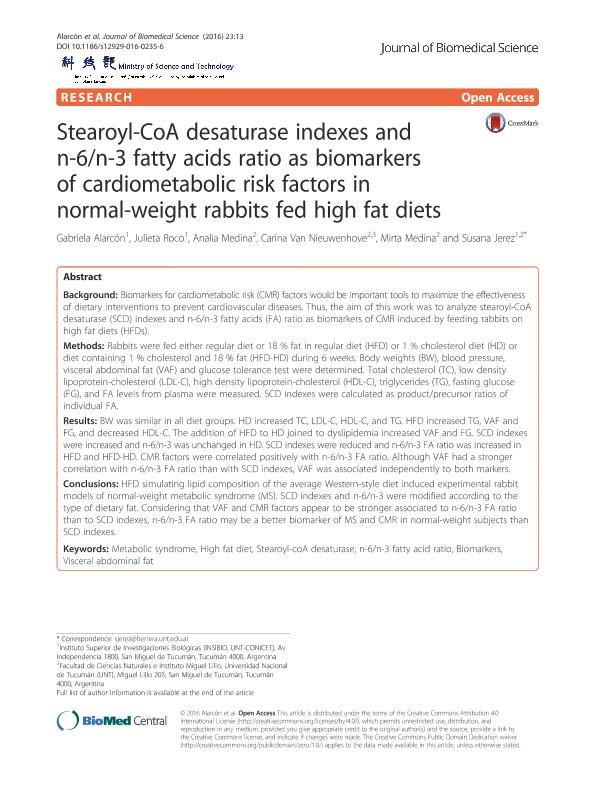Mostrar el registro sencillo del ítem
dc.contributor.author
Alarcón, Gabriela del Jesús

dc.contributor.author
Roco, Julieta

dc.contributor.author
Medina, Analía de Los Angeles

dc.contributor.author
Van Nieuwenhove, Carina Paola

dc.contributor.author
Medina, Mirta Asunción

dc.contributor.author
Jerez, Susana Josefina

dc.date.available
2018-09-26T17:59:53Z
dc.date.issued
2016-01-20
dc.identifier.citation
Alarcón, Gabriela del Jesús; Roco, Julieta; Medina, Analía de Los Angeles; Van Nieuwenhove, Carina Paola; Medina, Mirta Asunción; et al.; Stearoyl-CoA desaturase indexes and n-6/n-3 fatty acids ratio as biomarkers of cardiometabolic risk factors in normal-weight rabbits fed high fat diets; BioMed Central; Journal Of Biomedical Science; 23; 13; 20-1-2016; 1-8
dc.identifier.issn
1021-7770
dc.identifier.uri
http://hdl.handle.net/11336/60917
dc.description.abstract
Background: Biomarkers for cardiometabolic risk (CMR) factors would be important tools to maximize the effectiveness of dietary interventions to prevent cardiovascular diseases. Thus, the aim of this work was to analyze stearoyl-CoA desaturase (SCD) indexes and n-6/n-3 fatty acids (FA) ratio as biomarkers of CMR induced by feeding rabbits on high fat diets (HFDs). Methods: Rabbits were fed either regular diet or 18 % fat in regular diet (HFD) or 1 % cholesterol diet (HD) or diet containing 1 % cholesterol and 18 % fat (HFD-HD) during 6 weeks. Body weights (BW), blood pressure, visceral abdominal fat (VAF) and glucose tolerance test were determined. Total cholesterol (TC), low density lipoprotein-cholesterol (LDL-C), high density lipoprotein-cholesterol (HDL-C), triglycerides (TG), fasting glucose (FG), and FA levels from plasma were measured. SCD indexes were calculated as product/precursor ratios of individual FA. Results: BW was similar in all diet groups. HD increased TC, LDL-C, HDL-C, and TG. HFD increased TG, VAF and FG, and decreased HDL-C. The addition of HFD to HD joined to dyslipidemia increased VAF and FG. SCD indexes were increased and n-6/n-3 was unchanged in HD. SCD indexes were reduced and n-6/n-3 FA ratio was increased in HFD and HFD-HD. CMR factors were correlated positively with n-6/n-3 FA ratio. Although VAF had a stronger correlation with n-6/n-3 FA ratio than with SCD indexes, VAF was associated independently to both markers. Conclusions: HFD simulating lipid composition of the average Western-style diet induced experimental rabbit models of normal-weight metabolic syndrome (MS). SCD indexes and n-6/n-3 were modified according to the type of dietary fat. Considering that VAF and CMR factors appear to be stronger associated to n-6/n-3 FA ratio than to SCD indexes, n-6/n-3 FA ratio may be a better biomarker of MS and CMR in normal-weight subjects than SCD indexes.
dc.format
application/pdf
dc.language.iso
eng
dc.publisher
BioMed Central

dc.rights
info:eu-repo/semantics/openAccess
dc.rights.uri
https://creativecommons.org/licenses/by-nc-sa/2.5/ar/
dc.subject
Biomarkers
dc.subject
High Fat Diet
dc.subject
Metabolic Syndrome
dc.subject
N-6/N-3 Fatty Acid Ratio
dc.subject
Stearoyl-Coa Desaturase
dc.subject
Visceral Abdominal Fat
dc.subject.classification
Otras Ciencias de la Salud

dc.subject.classification
Ciencias de la Salud

dc.subject.classification
CIENCIAS MÉDICAS Y DE LA SALUD

dc.title
Stearoyl-CoA desaturase indexes and n-6/n-3 fatty acids ratio as biomarkers of cardiometabolic risk factors in normal-weight rabbits fed high fat diets
dc.type
info:eu-repo/semantics/article
dc.type
info:ar-repo/semantics/artículo
dc.type
info:eu-repo/semantics/publishedVersion
dc.date.updated
2017-09-13T16:22:45Z
dc.identifier.eissn
1423-0127
dc.journal.volume
23
dc.journal.number
13
dc.journal.pagination
1-8
dc.journal.pais
Reino Unido

dc.journal.ciudad
Londres
dc.description.fil
Fil: Alarcón, Gabriela del Jesús. Consejo Nacional de Investigaciones Científicas y Técnicas. Centro Científico Tecnológico Conicet - Tucumán. Instituto Superior de Investigaciones Biológicas. Universidad Nacional de Tucumán. Instituto Superior de Investigaciones Biológicas; Argentina
dc.description.fil
Fil: Roco, Julieta. Consejo Nacional de Investigaciones Científicas y Técnicas. Centro Científico Tecnológico Conicet - Tucumán. Instituto Superior de Investigaciones Biológicas. Universidad Nacional de Tucumán. Instituto Superior de Investigaciones Biológicas; Argentina
dc.description.fil
Fil: Medina, Analía de Los Angeles. Universidad Nacional de Tucumán. Facultad de Ciencias Naturales e Instituto Miguel Lillo; Argentina
dc.description.fil
Fil: Van Nieuwenhove, Carina Paola. Universidad Nacional de Tucumán. Facultad de Ciencias Naturales e Instituto Miguel Lillo; Argentina. Consejo Nacional de Investigaciones Científicas y Técnicas. Centro Científico Tecnológico Conicet - Tucumán. Centro de Referencia para Lactobacilos; Argentina
dc.description.fil
Fil: Medina, Mirta Asunción. Universidad Nacional de Tucumán. Facultad de Ciencias Naturales e Instituto Miguel Lillo; Argentina
dc.description.fil
Fil: Jerez, Susana Josefina. Consejo Nacional de Investigaciones Científicas y Técnicas. Centro Científico Tecnológico Conicet - Tucumán. Instituto Superior de Investigaciones Biológicas. Universidad Nacional de Tucumán. Instituto Superior de Investigaciones Biológicas; Argentina. Universidad Nacional de Tucumán. Facultad de Ciencias Naturales e Instituto Miguel Lillo; Argentina
dc.journal.title
Journal Of Biomedical Science

dc.relation.alternativeid
info:eu-repo/semantics/altIdentifier/doi/http://dx.doi.org/10.1186/s12929-016-0235-6
dc.relation.alternativeid
info:eu-repo/semantics/altIdentifier/url/https://jbiomedsci.biomedcentral.com/articles/10.1186/s12929-016-0235-6
Archivos asociados
